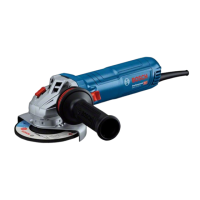14 | English
Material Application Grit
– Car paint
– Stone
– Marble
– Granite
– Ceramic
– Glass
– Perspex
– Fibreglass reinforced plastics
For pre-sanding Coarse 80
For shaping and edge chamfering Medium 100
120
For fine sanding during shaping Fine 180
240
320
400
Buffing and edge rounding Very fine 600
1200
Selecting a sanding pad
The power tool can be fitted with sanding pads of various
hardnesses, depending on the application:
– Soft sanding pad: Suitable for polishing and sensitive
sanding even on curved surfaces.
– Medium sanding pad: Suitable for all sanding work, uni-
versal application.
– Hard sanding pad: Suitable for heavy sanding on flat sur-
faces.
Changing the sanding pad (see figure B)
Note: Replace damaged sanding pads (8) immediately.
Remove the sanding sheet or polishing tool. Unscrew the
screw completely (11) and remove the sanding pad (8). At-
tach the new sanding pad (8) and retighten the screw.
Note: When attaching the sanding pad, make sure that the
teeth of the catch mate with the recesses in the sanding pad.
Note: Damaged sanding pads must only be replaced by an
after-sales service centre authorised to work with Bosch
power tools.
Dust/Chip Extraction
The dust from materials such as lead paint, some types of
wood, minerals and metal can be harmful to human health.
Touching or breathing in this dust can trigger allergic reac-
tions and/or cause respiratory illnesses in the user or in
people in the near vicinity.
Certain dusts, such as oak or beech dust, are classified as
carcinogenic, especially in conjunction with wood treatment
additives (chromate, wood preservative). Materials contain-
ing asbestos may only be machined by specialists.
– Use a dust extraction system that is suitable for the ma-
terial wherever possible.
– Provide good ventilation at the workplace.
– It is advisable to wear a P2 filter class breathing mask.
The regulations on the material being machined that apply in
the country of use must be observed.
u Avoid dust accumulation at the workplace. Dust can
easily ignite.
Self-generated dust extraction with dust box (see figures
C1–C4)
Before fitting the dust box (6), remove the plastic slider
(13). Fit the dust box (6) onto the extraction outlet (14) so
that it clicks into place. Make sure that the plastic slider (13)
is partly within the bracket (12).
To empty the dust box (6), press the locking lever (15) on
the side of the dust box (). Remove the dust box by pulling
it downwards ().
Before opening the dust box (6), knock the dust box against
a firm surface as shown in the figure to loosen the dust from
the filter element.
Take hold of the dust box (6) by the recessed grip, fold the
filter element (16) upwards out of the way and empty the
dust box. Use a soft brush to clean the flaps of the filter ele-
ment (16).
External dust extraction (see figure D)
Attach the dust extraction adapter (17) to the extraction
outlet (14). Make sure that the locking levers of the dust ex-
traction adapter lock into place. A dust extraction hose with
a diameter of 19mm can be connected to the dust extrac-
tion adapter (17).
To remove the dust extraction adapter (17), press its lock-
ing levers down simultaneously and take off the dust extrac-
tion adapter.
The dust extractor must be suitable for the material being
worked.
When extracting dry dust that is especially detrimental to
health or carcinogenic, use a special dust extractor.
When working on vertical surfaces, hold the power tool with
the dust extraction hose facing downwards.
Self-generated dust extraction with dust bag (see figure
E)
A dust bag (accessory) (19) can be used for smaller jobs.
Before fitting the dust bag (19), remove the plastic slider
(13). Firmly attach the dust bag nozzle to the extraction out-
let (14). Make sure that the plastic slider (13) is partly
within the bracket provided for the dust bag (19).
Empty the dust bag (19) at regular intervals to maintain op-
timum dust collection.
Auxiliary Handle
The auxiliary handle (1) enables comfortable handling and
optimum power distribution, with a high sanding removal
rate in particular.
Use the screw (2) to secure the auxiliary handle (1) on the
housing.
1 609 92A 7T4 | (24.05.2022) Bosch Power Tools

